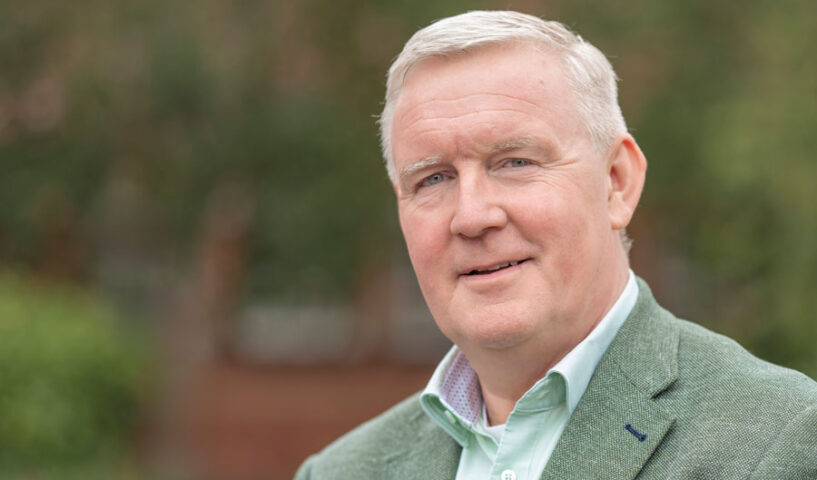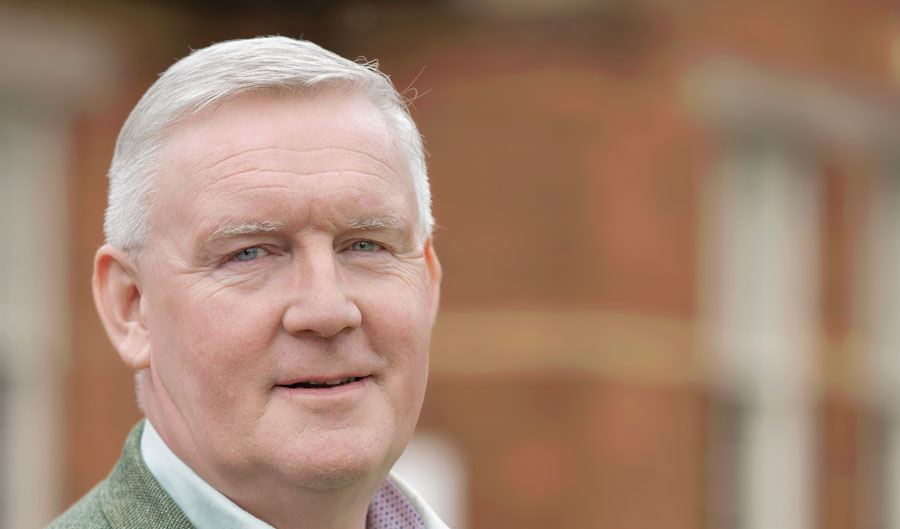
300GW of offshore wind energy by 2050
4th October 2024
Energy security in an all-island context
4th October 2024Beyond ‘brown to green’

John Reilly, Head of Renewable Energy.
Head of Renewable Energy, John Reilly, discusses the transformation of Bord na Móna into one of the largest generators of renewable electricity in the Irish market and outlines an ambition to have operational assets totalling 2GW by 2030.
On 23 December 2023, Ireland’s last Megawatt hour (MWh) of electricity from the burning of peat was generated at Edenderry Power Station in County Offaly, marking the successful completion of Bord na Móna’s radical ‘Brown to Green’ strategy.
Once a leading player in the domestic heating market, as recently as 2015, Bord na Móna partly contributed to the almost three million tonnes of direct CO2 emissions from peat-fired generation in Ireland.
Today, Bord na Móna’s transition to a successful climate solutions and renewable energy company is showcased as an international exemplar of how organisations involved in the fossil fuel industry can embrace – and thrive in – the energy transition.
The fact that the whole electricity sector is predicted to emit between just six and seven million tonnes of CO2 in 2024 is evidence of the emission reduction progress being made through the transitional actions of organisations like Bord na Móna. Reilly is proud of the company’s journey to date, but affirms that the removal of peat from the Irish energy mix is just “phase one” of Bord na Móna’s role in the energy transition.
The need to remove peat-fired generation in Ireland was officially signalled by the ending of the Public Services Obligation in 2016 but rather than winding up the business, Bord na Móna boldly opted to replace the generation from peat in the electricity sector with renewable forms of generation.
Reilly explains that, to date, this has mainly equated to replacing peat with sustainable biomass at the Edenderry Power Station and replacing the MWh of generation that previously came from peat with other forms of renewable generation.
Land bank
One of the strategic advantages which is essential to Bord na Móna’s transition from its traditional industry highlighted by Reilly is its 80,000 hectare land bank, which has been central to its operations.
“It is important to stress that Bord na Móna has always been an energy company and our land bank has always played a crucial role in Ireland’s security of energy supply. There is a nice symmetry in the fact that this land bank will continue to play a crucial role in the provision of secure energy for the State, by enabling us to capture the energy that blows over it or shines down on it,” says Reilly.
Renewable generation
Between 2010 and 2020, Bord na Móna doubled its level of installed capacity in the Irish electricity sector to 500MW and between 2020 to 2025 has almost doubled that again – meaning that by the end of 2025, it will have almost 1GW of operational renewable assets.
This is made up of one of the largest onshore wind portfolios on the island of some 600MW, 118MW of baseload capacity in the form of biomass-fuelled generation, and Bord na Móna’s first soon-to-be-operational utility-scale solar project, part of a co-development agreement with ESB.
Asked why, given its evident success in onshore wind development, Bord na Móna continues to diversify its renewable portfolio, Reilly states: “Diversification is important to us because we want our portfolio to mirror the needs of the electricity power system as a whole. While wind and solar will play a huge role in our future energy system, it is recognised that intermittent renewables will not meet all the needs of the power system at all times.
“Therefore, we see the value in access to backup capacity, which is where biomass provides baseload capacity, but we are also very interested in investing in technologies that support the increased deployment of those intermittent renewables.
“As a sector, we have delivered close to 5GW of operational onshore wind to date, which means there is little reason that we cannot quickly raise that to 10GW.”
“So, we are interested in investing in further flexible gas-fired capacity, for example, and have just commissioned our first battery project, which is a 25MW, three-hour battery.”
However, while Bord na Móna will continue to diversify its renewable portfolio in an effort to mirror the electricity demand out to 2040, Reilly emphasises that onshore wind will continue to be a massive part of renewable energy generation in the coming years and, as such, is an area of strategic ambition for Bord na Móna.
“Our ambition now is to double our current capacity again between now and 2030,” he says, adding: “The question is, can we deliver an additional 600MW to 700MW in the period from now to 2030. It is a significant challenge, but that is our ambition.”
Challenge
Outlining the barriers inhibiting the ambition of moving from 1GW to 2GW of operating assets in the coming years, the Head of Renewable Energy specifically points to the challenges in navigating the planning system.
“Unfortunately, what we have seen in recent years is a significant increase in the time it takes to get any major infrastructure project through the system – and this challenge is not unique to energy.
“The planning system is struggling to cope with the level of change required in modern Ireland and I think we are seeing recognition of that in the Government’s discussions around the possible creation of a Department for Infrastructure.
“Our 600MW of operational onshore wind capacity is evidence of our ability to deliver. As a sector, we have delivered close to 5GW of operational onshore wind to date, which means there is little reason that we cannot quickly raise that to 10GW. For now, the global market is still very much focused on Ireland as an investment destination but the planning system represents the biggest bottleneck and barrier to our growth objectives.”
Reilly outlines an assessment completed by Bord na Móna that suggests the potential for 3GW of installed capacity on its landbank alone, which could be in place by 2035 under an efficient planning system.
He suggests that a slowdown in growth – largely attributed to the planning system – coupled with growing demand has prolonged the necessity for onshore wind development for at least the next decade, where previously it was expected that greater project delivery focus would be given to the offshore sector.
Offshore
As per a sector wide consensus, Reilly expects offshore wind to become the dominant renewable generation technology in Ireland at some stage between 2030 and 2040, but finds it difficult to pinpoint when that tipping point may occur. Delays in project development mean that the Government’s 5GW target for offshore generation by 2030 is unlikely to be met, and Reilly believes the focus now should turn to prioritising renewable generation that can be operational by 2030, in the knowledge that offshore wind is coming at scale.
Discussing Bord na Móna’s ambition to develop offshore infrastructure in the coming years, he says: “In the coming decade, offshore wind is set to gradually overtake the need for having any more capacity onshore. Our onshore wind assets tend to be relatively new, and our projects tend to be at the larger end of the spectrum.
“We have higher capacity factors in general in our wind farm sites than most of our competitors in the marketplace, and when you take that into account alongside our renewable energy generation from biomass and solar, I expect us to be the largest generator of renewable electricity in the Irish market in 2024.
“That is quite remarkable when you consider where we were coming from 10 years ago, but it also begs the question as to how we might maintain that position as a market leader as we move from 2030 to 2040. Very quickly, it became clear to us that we would need to be involved in the offshore sector.”
At the end of 2022, Bord na Móna launched a major new partnership with international offshore wind expert Ocean Winds, which will see the organisations co-own, identify and develop offshore wind energy opportunities around the coast of Ireland. Early project development centres on two potential projects, Réalt na Mara, off the coast of counties Dublin and Wicklow, and Celtic Horizon, off the coast of counties Wexford and Waterford. The projects have a combined potential to generate 2.3GW. The recent move to a plan-led approach to the development of offshore wind will change aspects of the development programme, with a focus on the upcoming ORESS auctions and opportunities that may fall from the Future Framework for the development of offshore wind.
The Head of Renewable Energy articulates that Bord na Móna was steadfast in its commitment to only enter the market in partnership with offshore wind expertise.
“Many of the skillsets involved in delivering onshore wind projects are transferable and applicable, meaning that Bord na Móna was well equipped. However, we are also very aware of the sectoral differences and honest about the skills that we do not have.
“In Ocean Winds, we found a partner who brought that experience and expertise but who also valued our experience around things like the operations of the Irish market, and community engagement on large infrastructure projects.”
Reilly adds: “It is a partnership that makes a lot of sense and is a key part of future-proofing our role as a renewable energy company. However, we have not in any way lost our focus on our core activity, which is delivering new renewable assets on our land bank.”
Eco Energy Parks
Reilly is cognisant that the pace of planning is not the only challenge to renewable energy development in Ireland, indicating that even if all projects in the pipeline were approved tomorrow, securing timely and cost-effective grid solutions to get projects away, also remains a significant challenge.
Pointing out that while Ireland has a relatively flexible and new electricity grid, he highlights how the footprint of that grid has barely increased in over a decade, leading to difficulties in securing grid capacity.
Most of Ireland’s renewable generation infrastructure is sited in the west, while the largest concentration of demand is in the east, and as the level of renewable generation increases, ensuring that this generation capacity is used efficiently has become a greater challenge and requires new innovation.
“There is a real challenge in connecting large energy users or large demand customers, particularly in the Dublin region,” explains Reilly. “What we have been working on is the idea that given our large sites in regions such as the midlands and the eastern seaboard, we are strategically placed close to large demand.
“Given the existing grid network in those areas, we believe that with targeted extensions of that network onto parts of our land bank, the opportunity exists to co-locate renewable generation assets alongside large demand customers.”
Bord na Móna is exploring the potential to deliver multiple Eco Energy Parks on its land bank, which will co-locate large companies with a range of renewable energy technologies, enabling the delivery of low-carbon growth and contributing to associated enterprise, community initiatives, local amenities, and the local natural environment.
In April 2024, Amazon Web Services became the first business to join the first-of-its-kind Bord na Móna Eco Energy Park in the Midlands. The Eco Energy Park sees Bord na Móna investing to deliver wind and solar power – flexible back-up generation to support grid resilience when required and developing new electricity grid connections.
Outlining that the Eco Energy Park concept has gained significant favour, Reilly says that interest has spanned far beyond data centres and the ICT sector and engagement has taken place with organisations from across the economic spectrum. This includes companies ranging from the pharmachem sector through to manufacturing, all of whom see the benefits of utilising renewable energy to power their operations and reduce their emissions.
“Instead of dwelling on the barriers, we are gearing up to be ready for when these barriers are removed and realising our ambition to have 2GW of installed capacity by 2030.”
Socioeconomic impact
Reilly is proud of the enabling role Bord na Móna is playing in economy-wide decarbonisation and stresses his belief that Ireland can continue to be a leading destination for foreign direct investment as the “global hunt for green energy” intensifies.
Discussing the impact this transition will have on local communities, he says: “It is very important that we, as a country, get this piece of the transition right. We need to be honest about the fact that to reach our ambitions and to unlock the economic benefits, there needs to be a lot more investment particularly in critical infrastructure.
“As a sector, we know that all stakeholders including utility companies, government, politicians, and leaders must better explain to people the advantages of what we are trying to achieve. There must be an honesty in the fact that some of this infrastructure will change the vista but there must also be a way of communicating the benefits of providing secure and reliable forms of electricity in a way that will radically improve our society and bring added benefits such as improved air quality.
“In addition, a core part of our work is ensuring that local communities in the proximity to these large pieces of infrastructure benefit the most and our community benefit funds are designed to ensure this happens.”
Bord na Móna’s commitments to sustained future growth and the delivery of the renewable energy pipeline are also balanced with a responsibility for peatlands rehabilitation. In the 12-months to March 2024, the organisation restored 3,911 hectares of natural peatlands as part of its Peatlands Climate Action Scheme (PCAS) and has acted to ensure parts of its landbank are opened up to public use.
Beyond individual communities, Bord na Móna believes it can help develop a vibrant ecosystem that places the Midlands region at the forefront of the carbon zero economy and enable the creation of high value jobs in the region. A New Beginnings programme commenced in June 2023, designed to support the exit of employees, impacted by the cessation of peat production, who had a desire to start their own business. Its success paved the way for a second iteration which commenced in March 2024, which enrolled 14 participants.
Reilly explains that Bord na Móna also continues to support innovative businesses and founders with sustainability ambitions via its Accelerate Green programmes. Since 2022, more than 40 companies have completed the leading sustainability accelerator programme which is dedicated to supporting companies interested in scaling or developing products and services based on green innovation. Bord na Móna also introduced Accelerate Green Start, a programme for earlier stage start-ups in the climate and sustainability sectors, with companies developing some of Ireland’s newest sustainable innovations and creating climate-focused solutions for a variety of industries in Ireland and internationally.
Future
In July 2024, Bord na Móna celebrated the 90th anniversary of its inception – as the then-Turf Development Board – and Reilly believes that an historical circularity exists given the remit of the original company in helping the then-fledgling State to meet its energy needs in a secure way, and what Bord na Móna is striving towards today: contributing to indigenous and renewable energy security.
Concluding by describing the journey of Bord na Móna over his 25-year energy career as “phenomenal”, Reilly says that there is a lot to be optimistic about in the coming years.
“I think often it is easy to look at the energy transition and focus on the negatives, such as the planning bottleneck and inadequate grid capacity, but our view is that these are challenges which have been identified and can be rectified. Instead of dwelling on the barriers, we are gearing up to be ready for when these barriers are removed and realising our ambition to have 2GW of installed capacity by 2030.
“We will leave no stone unturned in this endeavour and have confidence that Bord na Móna’s journey to date underpins our ability to successfully break new ground.”


